
Olearia argophylla is a species of flowering plant in the family Asteraceae. Its common names are musk daisybush, musktree, muskwood and silvershrub. It is found in Australia, specifically in New South Wales, Tasmania and Victoria. It grows as a tall shrub or tree characteristic of wet sclerophyll forest. Its leaves are large and broad, coarsely toothed, green on top and silver-white underneath. The grain of the wood is mainly straight, but burls near the base of the tree are prized for their brown swirls that often suggest the appearance of small faces or animals peering out of the wood, making them highly sought after by woodworkers.
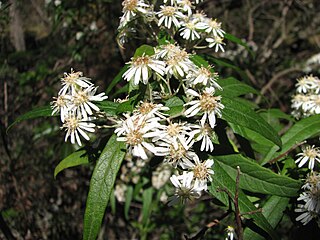
Olearia lirata, the snowy daisy-bush or dusty daisy-bush, is a species of flowering plant in the family Asteraceae. It occurs in moist forest and scrub in New South Wales, Victoria, and Tasmania.

Olearia phlogopappa commonly known as the dusty daisy-bush or alpine daisy-bush is a species of flowering plant in the family Asteraceae that is commonly found in eastern New South Wales, Victoria and Tasmania. It is a small shrub with greyish-green foliage, daisy-like flowers in white, pink or mauve that can be seen from spring to late summer.

Ozothamnus obcordatus is a shrub in the family Asteraceae, native to the states of Queensland, New South Wales, Victoria and Tasmania in Australia.

Olearia megalophylla, the large-leaf daisy bush, is a species of flowering plant in the family Asteraceae. It is a shrub up to 2 metres high with scattered leaves. These are dark green above, woolly underneath, and are 20 to 120 mm long and 6 to 28 mm wide. The flower heads have 5 to 9 white ray florets and 9 to 14 yellow disc florets. The species was first formally described by Ferdinand von Mueller in Papers and Proceedings of the Royal Society of Tasmania in 1859 and named Eurybia megalophylla. In 1865, he placed the species in the genus Aster and finally in Olearia in 1867. It occurs in moist sclerophyll forest in south-eastern New South Wales and Victoria.

Olearia erubescens, commonly known as moth daisy-bush or pink-tip daisy-bush, is a species of flowering plant in the family Asteraceae. It is a shrub with stiff, prickly leaves and white "daisy" flowers, growing up to 2 metres high.

Olearia floribunda, commonly known as heath daisy-bush, is a species of flowering plant in the family Asteraceae.

Olearia astroloba, commonly known as Marble daisy-bush, is a rare shrub species in the family Asteraceae. It is endemic to the state of Victoria in Australia.

Olearia elliptica, commonly known as the sticky daisy bush, is a shrub in the daisy family, Asteraceae and is native to New South Wales and Queensland in eastern Australia. It has scattered, sticky leaves and white flowers in summer and autumn.

Olearia suffruticosa, commonly known as clustered daisy-bush, is a species of flowering plant in the family Asteraceae. It is a shrub to 0.7 metres high with scattered, linear leaves. The "daisy" flower heads have 14 to 20 white or pink ray florets and 18 to 28 disc florets. These occur between January and April in the species' native range.

Olearia myrsinoides, commonly known as silky daisy-bush, is a species of flowering plant in the family Asteraceae. It is a shrub to 1.5 metres high with toothed leaves. These are dark green above and tomentose underneath. The flower heads have 2 to 4 white ray florets and 3 to 4 pale yellow or violet disc florets. These appear between November and March in the species' native range. The species was formally described in 1806 in Novae Hollandiae Plantarum Specimen by French naturalist Jacques Labillardière who named it Aster myrsinoides. In 1867 it was transferred to the genus Olearia in Flora Australiensis.
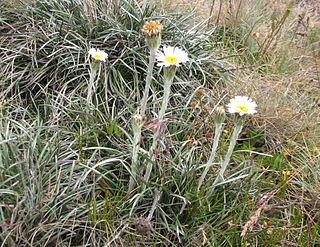
Celmisia pugioniformis, commonly known as slender snow-daisy, is a species of perennial herb in the family Asteraceae. It is native to south-eastern Australia. Leaves are 10 to 20 cm long and 2 to 6 mm wide, with an olive green or grey green upper surface. The daisy-like flowerheads, which are 6 to 8 cm in diameter, appear between December and February in the species native range. The species was formally described in 1992 in the Flora of New South Wales. Prior to 1992, plants had been included under the name Celmisia asteliifolia.
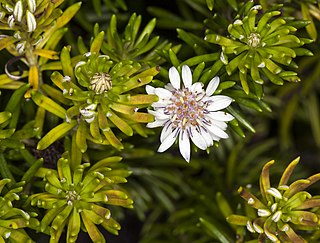
Olearia ballii, commonly known as the Mountain Daisy, is a shrub in the daisy family, Asteraceae. The specific epithet honours Lieutenant Henry Lidgbird Ball who, while commanding HMS Supply in 1788, discovered and named Lord Howe Island, where the plant was subsequently collected.
Olearia mooneyi, commonly known as pumpkin bush, is a large shrub or small tree in the daisy family, Asteraceae. The specific epithet honours Thomas Mooney (1842–1873), an early settler of Lord Howe Island who was interested in its plants.
Olearia adenolasia, commonly known as woolly-glandular daisy-bush, is a species of flowering plant in the family Asteraceae. It is a small upright shrub with sticky leaves and blue-purple or white daisy flowers.
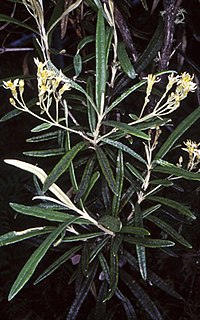
Olearia alpicola, commonly known as alpine daisy bush, is a shrub in the family Asteraceae and is found in mountainous terrain in New South Wales and Victoria in Australia. A small shrub with spreading branches and white daisy-like flowers.

Olearia magniflora, commonly known as the splendid daisy-bush, is a small shrub with clusters of deep mauve to purple flowers.

Olearia ciliata, commonly known as the fringed daisy bush, is a small shrub with large clusters of bright purple-blue flowers on a single stem.
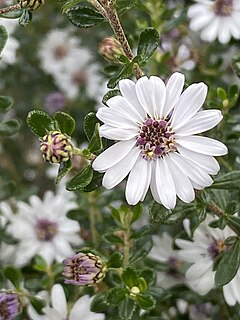
Olearia minor, is a small flowering shrub in the family Asteraceae. It has alternate leaves and white to pale mauve daisy-like flowers from winter to December. It grows in Western Australia, South Australia, New South Wales, and Victoria.

Olearia oppositifolia is a species of flowering plant in the family Asteraceae and is endemic to eastern Australia. It is a shrub with egg-shaped to elliptic leaves arranged in opposite pairs, and white and yellow daisy flowers.


















